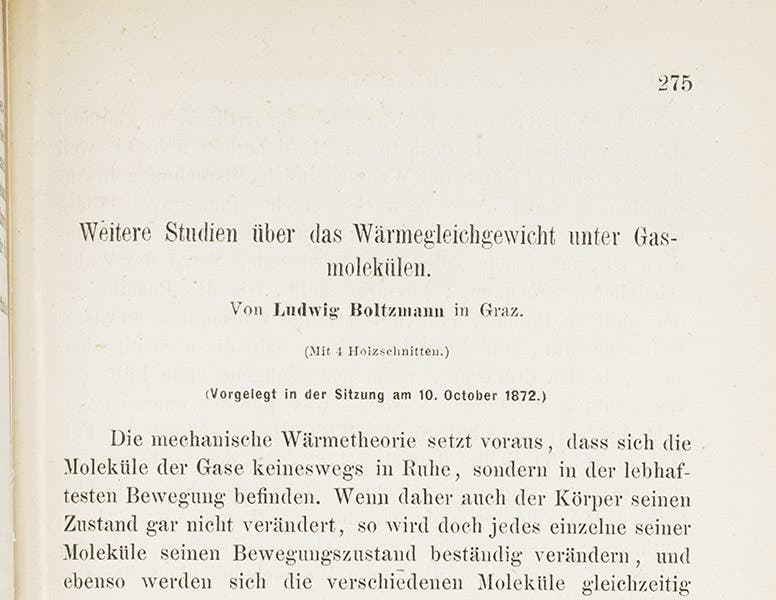Scientist of the Day - Ludwig Boltzmann

Ludwig Boltzmann, an Austrian physicist, was born Feb. 20, 1844. Boltzmann was a founder of what is called statistical thermodynamics. By assuming that a gas is made up of atoms moving with random velocities in all directions, he was able to predict large-scale (macroscopic) properties of the gas, such as its temperature and pressure, with great accuracy. He was also able to measure and predict the growing disorder of any system, what we call its entropy, from the random behavior of its constituent atoms. He announced all this in a paper with the disarming title of "Further studies on the thermal equilibrium of gas molecules", that was published in the Proceedings of the Academy of Sciences of Vienna in 1872 (second image). If ever there were a seminal paper that founded a new field and a new way of looking at the world, this was it. Many years ago, we organized a very successful exhibition at the Library in which we displayed 40 seminal scientific papers, such as Newton's 1671 paper on the nature of light and Einstein's 1905 paper on special relativity. We did not include Boltzmann's paper. That was a serious omission, for which I take the blame. Fortunately, I know better now.
It seems odd to us today that such a milestone contribution met a great deal of resistance for 35 years. The problem was that, for Boltzmann, the predictive success of statistical thermodynamics was evidence for the real existence of atoms, and he was not shy about proclaiming this. But many physicists at the end of the 19th century refused to believe in atoms as real objects. Major figures such as Ernst Mach and William Ostwald were persuaded by Maxwell's field theory that the universe is a continuum of forces and fields, and that discrete entities such as atoms and molecules are unnecessary and unverifiable. It was not until Einstein's paper on Brownian motion of 1905 and Jean Perrin's verification of Einstein that the existence of molecules and atoms began to be taken seriously by physicists, and this was too late for Boltzmann. He had always been subject to fits of depression--we would probably diagnose him today as a manic-depressive--and while on a family visit to Switzerland in 1906, Boltzmann hanged himself.
Boltzmann's tomb in Vienna is one of the more appealing scientific monuments (first image). Above a portrait bust of Boltzmann, a single simple equation is carved into the marble: S = k log W. This is Boltzmann's equation for entropy. It is not quite as famous as E = mc2, but among students of thermodynamics, it is close. The constant "k" in this equation is known as Boltzmann's constant.
Dr. William B. Ashworth, Jr., Consultant for the History of Science, Linda Hall Library and Associate Professor, Department of History, University of Missouri-Kansas City. Comments or corrections are welcome; please direct to ashworthw@umkc.edu.







